As an Amazon Associate, I earn from qualifying purchases at no extra cost to you.
How to Tell If Your Oven Is Gas or Electric: Expert Guide
When it comes to cooking, knowing whether your oven is gas or electric can make a big difference in how you cook and how you maintain it. But if you aren’t sure, don’t worry! In this article, we’ll help you easily figure out whether your oven runs on gas or electricity. This knowledge can save you time, effort, and even money. Let’s dive in!
What Are the Key Differences Between Gas and Electric Ovens?
Before we get into how to tell if your oven is gas or electric, let’s first understand the key differences between the two. This will not only help you figure out which type of oven you have, but also explain why the difference matters.
How Gas Ovens Work
Gas ovens use natural gas to heat up the air inside the oven. The gas is burned, producing heat that cooks your food. The flame is visible when you open the oven door or turn the oven on. In most cases, the oven will have a gas burner at the bottom or in the back.
Gas ovens heat up faster than electric ones because the flame is immediately visible. This also makes them easier to adjust, allowing you to control the heat more directly. Some cooks prefer gas ovens because they offer better heat control, and they usually give a more even cook.
How Electric Ovens Work
Electric ovens, on the other hand, use heating elements to produce heat. These elements get hot when electricity flows through them, and they radiate heat into the oven to cook the food. The heating elements are typically found at the top and bottom of the oven. In many cases, the heating elements glow red when the oven is on and heating up.
Electric ovens usually take a little longer to heat up compared to gas ovens because they don’t have the instant flame of gas. However, many people prefer them for baking, as they provide more even heat distribution. Some models also have features like convection fans to help cook food more evenly.
Why It Matters
Understanding whether you have a gas or electric oven is important for a few reasons. For one, it can help you with cooking techniques. Gas ovens provide more instant heat, which may be ideal for certain cooking methods like roasting or broiling. Electric ovens, with their even heat, are great for baking and slow cooking.
Additionally, maintenance and repair are different depending on the type of oven you have. Gas ovens require you to check for any gas leaks, while electric ovens need you to inspect their heating elements from time to time. Knowing the type of oven you have can make it easier to take care of it.
How to Identify a Gas Oven
If you’re unsure whether your oven runs on gas, there are several signs to look for that can easily tell you if it’s a gas oven. Let’s walk through the key indicators.
Visible Flame or Burners
One of the most obvious signs that your oven is gas-powered is the presence of a flame or burners. Gas ovens often have a small flame at the back of the oven when you turn it on. If you see flames flickering or burning, you’re likely dealing with a gas oven. Gas ovens often have a visible flame or burner in the oven’s bottom section.
When you open the oven door, check for any visible flame or burner at the back. You may also notice that the oven heats up quickly as the flame is ignited.
Pilot Light
Older gas ovens often have a small, always-on pilot light that keeps the gas flowing until the oven is turned on. The light is often located inside the oven, near the burner. If you spot a small blue flame inside, that’s a good sign that your oven is gas-powered.
Some modern gas ovens don’t have pilot lights, as they use electronic ignition systems. However, the basic principle of the gas-burning flame still applies. If you see any kind of ignition when you turn the oven on, it’s likely a gas oven.
Control Knobs
Many gas ovens have control knobs that are used to turn on the oven and adjust the temperature. These knobs are often more noticeable than the buttons found on electric ovens. Gas ovens may also have a unique clicking sound when you turn the knob to ignite the gas. If you hear a clicking sound when turning on the oven, there’s a good chance it’s gas.
Gas Line Connection
If you can access the back of your oven, look for a gas line connection. Gas ovens require a natural gas or propane line to function. If you see a flexible gas line connected to the oven, it’s an easy indicator that the oven runs on gas.
Absence of Heating Elements
Unlike electric ovens, gas ovens do not have the metal coils or heating elements that glow red when the oven is turned on. If you don’t see any coils or glowing elements inside the oven, that’s a clear sign that it’s powered by gas.
How to Identify an Electric Oven
If your oven isn’t showing signs of being gas-powered, then it’s probably electric. However, there are some specific things to look for when identifying an electric oven. Let’s take a closer look.
Heating Elements
The most noticeable feature of an electric oven is the heating elements. These elements are typically made of metal and can be found on the top and bottom of the oven. When the oven is turned on, these elements glow bright red, indicating that they are heating up.
Electric ovens usually have two visible heating elements: one at the top for broiling and one at the bottom for baking. Some models have a third heating element in the back of the oven for even heat distribution.
Smooth Interior
Electric ovens often have smooth, even interiors without any visible burners or flames. The walls of the oven may look smooth and slightly reflective, and you may notice a slight glow from the heating elements when you open the door.
If your oven has a smooth interior, and you can’t find any visible flames or burners, it’s almost certainly electric. This design is one of the main differences between gas and electric ovens.
Control Buttons Instead of Knobs
Most electric ovens have control panels with buttons or digital dials instead of knobs. These control panels are often more modern and can include features like timers, temperature displays, and pre-set cooking options. If your oven has a sleek control panel, it’s likely electric.
Additionally, electric ovens are often equipped with digital displays that show the temperature and cooking modes. These features make electric ovens easy to control and monitor.
No Gas Line
Unlike gas ovens, electric ovens don’t require a gas line. If you don’t see a gas line running into the back of your oven, it’s a clear sign that your oven uses electricity to operate.
Longer Preheat Times
Electric ovens generally take longer to preheat compared to gas ovens. If you’ve noticed that your oven takes a bit more time to reach the desired cooking temperature, it could be electric. The heating elements need to heat up fully before the oven reaches the correct temperature, which is a slower process than lighting a gas flame.
Tips for Maintaining Gas and Electric Ovens
Whether your oven is gas or electric, it’s important to take care of it to ensure it works efficiently for years. Here are some tips for maintaining both types of ovens.
Maintenance Tips for Gas Ovens
- Check for gas leaks: Regularly check the gas line and burner for leaks. If you smell gas, turn off the oven immediately and call a professional.
- Clean the burners: Clean the burner grates and gas burners regularly to avoid food buildup and ensure even cooking.
- Ensure the ignition works: Check the ignition system to make sure it lights quickly and efficiently. If it’s not working properly, get it fixed right away.
Maintenance Tips for Electric Ovens
- Clean the heating elements: Wipe down the heating elements to prevent food buildup, which can cause them to overheat and burn out.
- Check for broken elements: If the heating elements stop glowing red or seem damaged, replace them. Broken elements can lead to uneven cooking.
- Keep the interior clean: Regularly clean the oven’s interior, especially around the heating elements, to maintain heat distribution.
I hope this article helped you figure out whether your oven is gas or electric. Knowing how your oven works will help you cook better and maintain it longer. Happy cooking!
Frequently Asked Questions
Is it safe to use a gas oven if you don’t smell gas?
Yes, as long as your gas oven is in good condition and there are no gas leaks, it is safe to use. Always check for leaks before use.
Can I convert a gas oven to electric?
It’s possible, but it can be expensive and complicated. It’s generally easier and safer to replace the oven with an electric model if needed.
Do I need a professional to install a gas oven?
Yes, gas ovens should be installed by a professional to ensure safety and proper installation.
Is it cheaper to use a gas oven or an electric oven?
Gas ovens are often cheaper to run in terms of energy costs, but electric ovens can be more efficient in terms of even cooking.
Is it possible to repair the heating elements of an electric oven?
Yes, heating elements can be replaced if they break. It’s usually an easy and inexpensive repair.
Can I use aluminum foil in my gas oven?
Yes, but be careful not to block air circulation or cover the oven’s heating elements.
Do I need to clean the vents in my electric oven?
Yes, regular cleaning of the vents and fans is important to maintain proper airflow and avoid overheating.
Is it safe to leave a gas oven on for a long period?
No, it’s not recommended to leave a gas oven on for an extended period. Always turn it off when not in use to avoid safety risks.



